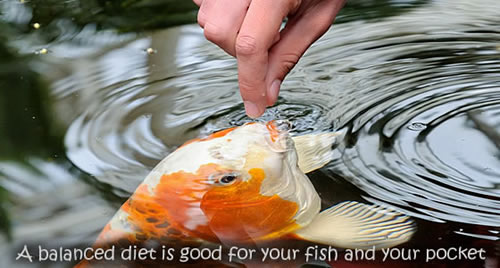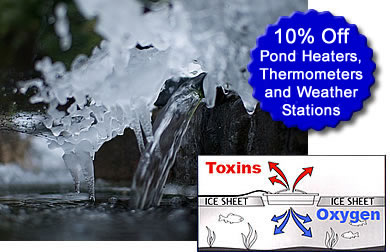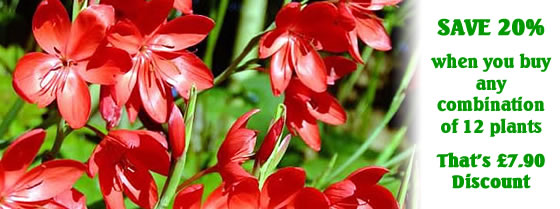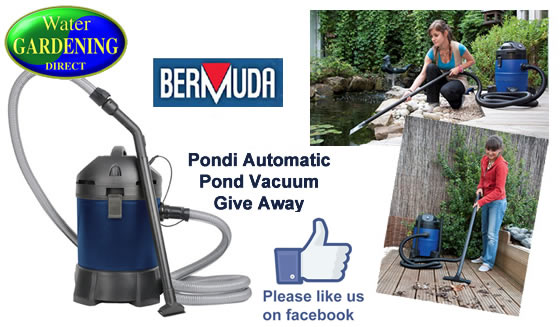Spring Time Feeding Advice |
 |
“To feed or not to feed, that is the question”Ok that’s not quite be how people are wording it, but it is the crux of the comments we are receiving at the moment. With the weather warming up nicely, the fish will soon be interested in feeding and whilst it is good to get some food down them you need to be wary. It is not only the physical activity of the fish which stops when the temperature drops in the autumn, it is also their digestive system. As such if you feed them now and the temperature drops to the point where they become inactive again, the food can sit in their gut and begin to decompose, which as I am sure you will understand is not good and so you need to be confident when feeding them that the temperature will be high enough over the next few days to fully digest the food and if the forecast says the weather is going to change stop feeding. The best food to feed them in the cooler temperature is Wheatgerm, which has been specifically designed to meet the fish’s needs at this time of year. ………Continue reading “Spring Time Feeding Advice” |
-
Water Gardening Direct Blog
Pond Equipment, Water Features, Aquarium Products and Spare Parts.
We hope our site has all the Help and Advice you need, but if not,
please feel free to give us a call on 01778 341199
or click here to order a FREE Brochure
See Our Latest Special Offers and Extra Discounts.
Water Gardening Direct Blog
-
Spring Time Feeding Advice
21 March 2014 by watergar
Category: Pond AdviceTags: Advice, Fish Feeding, Spring Time Feeding | Comments Off on Spring Time Feeding Advice
-
Fresh Marginal Pond Plants – Now In Stock
As the availability of Fresh Pond Plants is very dependent upon the time of year and weather conditions. We continually update our web pages to list the plants we actually have in stock. All of our Fresh Pond Plants come from the biggest grower in the UK who has over 45 years of cold water plant growing experience. We store all our Fresh Pond Plants outdoors and only supply Fresh Pond Plants that HAVE NOT been grown using forced growing techniques, such as heated greenhouses. So we can be sure that the plants we supply will be strong and healthy.
Fresh Marginal Pond Plants – Now In Stock
Get 20% DISCOUNT on every set of 12 plants (single type or mixed) To help with larger plant purchases, we will give you a £7.89 (equivalent to 20%) discount for every 12 plants you buy
28 February 2014 by watergar
Category: Pond Advice, Special OffersTags: Advice, Discounts, Pond Plants, Special Offers | Comments Off on Fresh Marginal Pond Plants – Now In Stock
-
Getting Your Pond Ready for Springtime
Although the winter has been very mild (yet very wet for many). Spring time is still a little way off, but hopefully the temperatures will continue to allow you to get out and start preparing for the warmer weather.
Before we go any further lets just clarify the question of fish feeding. It is very important not to start feeding your fish until the pond water reaches a consistent average temperature of at least 6 Deg C and at this level you should only use Wheatgerm based foods. Below this temperature, your fishes metabolism will slow to the point where undigested food can rot inside the gut. Additionally, bacteria in your filter will not be sufficiently active to process any waste that is produced by feeding fish, resulting in water pollution.
To keep you busy, it’s a great time to inspect and service your pond equipment. Your UV may need a new UV bulb as it requires replacement approximately every 6-12 months (dependant upon type). If replaced in the spring you will ensure it is working at its full potential as the green water starts to develop. The UV quartz should also be checked and cleaned to ensure maximum UV output. We suggest the use of a UV cleaning treatment which will clean your quartz without having to strip down you UV.
If you forgot to clean your filter before the shutdown in the autumn, thoroughly clean your foam and media with pond water. If your foams are more than 3 years old and feel soft and floppy they may be due for a change. Your can purchase replacement foams for your filter in singles or sets and gradually swap them over a period of a few weeks, but remember that most manufacturers will only honour their performance guarantees if genuine replacement foams are used.
See our full range of :
Wheatgerm Foods – UV Bulbs – UV Cleaning treatment – Replacement Foams – All Spare Parts
31 January 2014 by watergar
Category: UncategorizedTags: Advice, Cleaning, Spring, Spring Time Feeding | Comments Off on Getting Your Pond Ready for Springtime
-
FREE Prize Draw To All Our Facebook Fans
FREE Prize Draw To All Our Facebook Fans
As a special thank you to all our new and existing Facebook Fans, we are offing FREE entry into our PRIZE DRAW to win a Bermuda Pondi Automatic Pond Vacuum.
To enter, simply Like Use on Facebook and fill in your detail on our Prize Draw.
by watergar
Category: CompetitionTags: Cleaning, compitition, Planting Accessories, Special Offers | Comments Off on FREE Prize Draw To All Our Facebook Fans
-
Winter Special Offers
 Get an EXTRA 10% Discount off all these Winter Products
Get an EXTRA 10% Discount off all these Winter ProductsWinter will soon be here.
As any Koi keeper (from amateur enthusiast to professional breeder) will tell you, UK Winters provide a different set of challenges. Koi themselves aren’t native to the UK and so some care needs to be taken to ensure their comfort and survival.
What happens to Koi in Winter that is different from other times of year?
As soon as the water temperature falls below 5 degrees C, it becomes harder for the fish. Their systems begin to shut down to conserve vital energy level, not moving unless they really have to. It is nature’s way of enabling the Koi to cope with the demands of a climate they are not accustomed to. Luckily, they are extremely hardy and versatile creatures and have coped in every water system across the globe, with Antarctica being the only exception. At less than 5 degrees C, the Kio’s immune system is very low, which is why you can have problems with parasites and infections in the Springtime when the fish start to become active again.
Koi are ‘poikilothermic’, meaning cold-blooded and their body temperature is dictated by the surrounding water; telling their body functions when to respond and change, all regulated by the temperature. The metabolism of a Koi is dramatically reduced when they do not feed for long periods of time, as nature tells them to start limiting energy expenditure to cope with the demands of a cold environment which will last for an unknown period of time.
As the Koi’s metabolism slows to a crawl, they seek pockets of warmer water in the pond, where they will spend the majority of their time through the coldest months. They may appear torpid, even static, however they will move a small amount to prevent their joints from seizing. The state or torpor they are in is not quite fully-fledged hibernation, but it is similar, with reduced body temperature, slowed metabolism, reduced breathing rate, slower reaction times and primary body functions. They are almost treading water on the bottom, using as little energy as is possible. You may see Koi lined up side by side like soldiers, all facing the same direction. A common misconception is they are ‘huddled’, sharing body heat, but since they are ‘poikilothermic’ it wouldn’t make sense that they can share core body temperature like a Human could. It is more likely they are cramming into the warmest pocket of water, fitting as many as possible into the space. This process would be the same in a 1000 gallon pond or a 60 acre lake.
The above is extracted from an article written by Shaun Mitchell of Mitchkoi, the UK’s leading online Koi carp brand – Quality Koi delivered to your door.
With the above in mind what can a pond keeper do to help Koi in Winter?
Keep track of water and air temperatures using Digital Thermometer
Ideally you should have two thermometers; one for the water in the pond and one for the outside ambient temperature. The ambient temperature is a good indicator of where the weather is heading and what you should be doing in preparation for even colder weather well in advance. When temperatures start to fall below 12 degrees C, special care should be taken when making decisions regarding feeding and pond care.
Preventive Treatments – Formalin and Malachite Green
Many people believe it is a good idea to use a good general purpose treatment such as Formalin and Malachite Green before the cold snap sets in. Any issues that Koi have pre-winter can fester during the colder months and can worsen and become harder to treat. If you treat the problem beforehand you can reduce this risk and can ease the Koi through the cold weather. The thermometer will provide you with a guide as to whether you can treat your pond, however you should remember that many treatments will become less effective as the water temperature drops.
Minimize Chilling of the Water
Although the amount of Oxygen in the water is a much smaller problem in lower temperatures than in the summer, ensuring that the pond dose not freeze over, which would prevent Oxygen getting in and trap toxic gases inside is essential. To do this, continuing to circulate the water can greatly help. However leaving you air stones / discs at the base of your pond can create real problems as the rising bubbles will bring the warmer water at the base of the pond up to the surface where it is coldest. The same principle applies to water pumps, although circulating the pond water is still beneficial, moving your water pump and air stones / discs nearer to the surface of the pond will reduce there chilling effect. Waterfalls and skimmers should also be turned off in the winter as they can also chill the water.
Alternatively, the introduction of a small pond heater or ice preventer will keep an area of the pond free from ice and ensure good gas exchange
Warning – If you do get ice formation on your pond, do not smash the ice, as it can shock and kill your Koi.
Careful Feeding – Wheatgerm based foods
In the winter months, it is key to avoid overfeeding your Koi as the metabolism slows, their ability to digest a high protein growth food dwindles. It is wise to switch to an easy-to-digest Wheatgerm base food, and to feed the Koi less frequently. When the average temperature drops below 5 degrees C we suggest you stop feeding for the rest of the winter and restart feeding with Wheatgerm when temperatures rise in the spring.
15 November 2013 by watergar
Category: Pond Advice, Special Offers, WinterComments Off on Winter Special Offers



